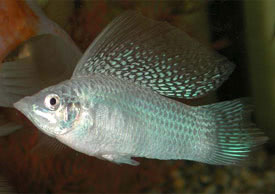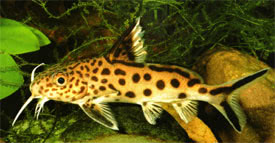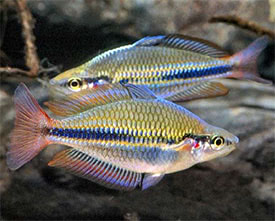
 Magyarul / Hungarian
Magyarul / Hungarian



- Scientific name: Herichthys carpintis
- Synonyms:Cichlasoma carpintis, Cichlasoma laurae, Cichlosoma laurae, Heros teporatus, Neetroplus carpintis
- Common name: Pearlscale Cichlid, Green Texas Cichlid, Carpinte Cichlid, Lowland Cichlid
- Group: Cichlids
- Habitat: Central America , Northern Mexico
- Size: 30 cm
- Biotope: Inhabits in lagoons, especially in Panuco river, but also occurs in fast-flowing rivers.
- Social behavior: Territorial, especially during breeding. They usually eat smaller fish. Can be kept with similar sized, Central American cichlids in a large community tank.
- Diet: Omnivorous, beside live and frozen foods, they readily accept dry foods, but require some vegetable matter, like spirulina flakes too.
- Breeding: Quite easy
- Tank: Minimum 300 litres.
- Population: 1 pair for 400 litres
- Decoration: Divide the tank into territories, using roots and rocks which they can occupy and defend. They can easily uproot the plants, as they dig in the substrate. Requires a large and well filtered mature tank.
- Temperature: 23-33 °C
- pH: 7-8
- Hardness: 9-20 NK°
- Lifespan: 10-12 years
Description: The Green Texas Cichlid is a beautiful fish. It is an oval-shaped, laterally compressed cichlid with a concave forehead, and an arched back. Herichthys carpintis has a tan to yellowish orange base color and a pattern of large, irregular spots with blue-green sheen. They are very similar in appearance to Herichthys cyanoguttatus, but their sports different in size and shape. Herichthys cyanoguttatus has small, relatively uniform spots, whereas the Herichthys carpintis has large, irregular spots. A regional variant of Pearlscale Cichlid also has worm-like markings toward the mouth and below the eyes.
Females have a black blotch on their dorsal fin, and they are smaller and deeper bodied than males. Breeding is quite easy, but the male may become aggressive with the female, so it is advisable to use a tank divider in case of necessity. During courtship both fish will display to each other when circle around and flap tails at the others’ body. During spawning both fish will change their color: the front part of their body become whiteish, while the rear become black. It is a good sign that the fish ready to spawn. They usually spawn on a previously cleaned large, flat rock. After the female Pearlscale Cichlid lays the eggs, the male moves in and fertilise them. The eggs are guarded by both parents, and each fish fan them with their pelvic fins to provide oxygenated water to them. The eggs will hatch in 2 days, when the parents usually transport them into another spawning pit, that they dug previously to the substrate. The fry become free-swimming after about a week, and can be fed with newly hatched brine shrimp.








































